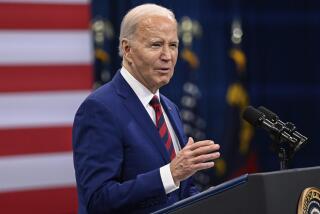Tsongas and Brown Near Tie in Maine : Campaign: Former senator is leading Californian, 29.7% to 29.3%. Clinton finishes 4th, behind ‘uncommitted.’ Bush sweeps the GOP side.
- Share via
PORTLAND, Me. — Former Massachusetts Sen. Paul E. Tsongas appeared headed for the narrowest of victories in the Maine Democratic caucuses Sunday over the well-organized anti-Establishment campaign of former California Gov. Edmund G. (Jerry) Brown Jr.
Arkansas Gov. Bill Clinton was a distant fourth, trailing “uncommitted.”
With 94% of the delegates chosen, Tsongas held a lead of less than a percentage point: 29.7% to Brown’s 29.3%. An uncommitted slate had 15.6%; Clinton, 15.3%; Iowa Sen. Tom Harkin, 5%, and Nebraska Sen. Bob Kerrey, 3%. Tsongas led Brown by only 12 delegates.
The Maine system is a two-step process. Sunday’s caucuses were to choose up to 3,566 delegates to the state convention in May, which in turn will choose 23 delegates to the national convention in July. Independents were eligible to participate in either party’s caucuses.
About 200 delegate slots remained open, but because of the quirks of Maine’s election law, some or all of them might never be filled.
Maine Republicans, meanwhile, gave their sometime neighbor, George Bush, a comfortable lead over conservative commentator Patrick J. Buchanan. With 81% of the delegates chosen, Bush held a lopsided 88% to 4% lead. Bush has an estate in the seaside resort of Kennebunkport, near Portland.
The Democratic results were at best a surprise, at worst an embarrassment, to Tsongas and Clinton. Tsongas had been favored both because of his victory in New Hampshire last Tuesday and because he is from a neighboring state. Clinton has a good organization and was given a chance to win because caucuses ordinarily go to the candidate with the best organization. In fact, Clinton made a last-minute attempt to woo voters here to embarrass Tsongas. Neither Kerrey nor Harkin paid the state much heed, choosing to concentrate on South Dakota’s primary this Tuesday.
But Brown campaigned extensively in the state, especially in the last week, and had a good organization. He also took advantage of the state’s liberal heritage, tapping into the large group of Democrats who had never gone to a caucus but responded to what they considered a new political message, said Bill Diamond, who is Maine’s secretary of state and Kerrey’s campaign chairman.
“Brown scratched that itch,” Diamond said.
Tsongas, in South Dakota for a debate with five other Democratic contenders Sunday night, seemed unworried by Brown’s showing. “If these returns hold up, we’re running 2 to 1 ahead of the other major candidate,” he said. “My fight is with Bill Clinton . . . and I’m running 2 to 1 ahead of him.”
Brown, in turn, tweaked those who had discounted his candidacy. “It certainly is an upset and it has to be a shock to the pundits in Washington who early on decided that only $1,000 checks and obscene campaign war chests could propel a candidacy,” he said. “The people of Maine proved them wrong. . . . Our campaign is being carried on the shoulders of the American people. . . .
“I’m very pleased that we were able to break through the cynical barrier of Establishment politics.”
Brown will accept no contribution larger than $100; the legal limit is $1,000.
Brown’s Maine campaign team attributed his showing to the appeal of his message and to his focused and intensive campaigning. Brown had visited 31 Maine cities in five campaign swings since December, and had stumped the state every day since the Feb. 18 New Hampshire primary.
They also attributed the strong showing to the highly liberal bent of many Maine Democratic activists and to the anti-nuclear sentiment that Brown sought to tap. Anti-nuclear feeling remains strong in Maine, where its controversial Maine Yankee nuclear power station is a constant irritant to a portion of the population.
Officials of the Tsongas and Kerrey campaigns insisted that the real importance of the caucuses lay in the fourth-place showing of Clinton, whose Maine campaign had money, numerous party endorsements and a good organization.
“That’s the real story here,” said Dennis Newman, field coordinator for the Tsongas campaign. He said the Tsongas camp is “happy with our showing. . . . Caucuses will never be our strength.”
Clinton, in turn, tried to turn the results against Tsongas. “It’s awful news for Tsongas,” Clinton aide Paul Begala said. “Senator Tsongas spent the week trying to convince us he’s not a regional candidate; he’s a national candidate. Apparently he’s half right.”
Rick Barton, a former Democratic state chairman and a Clinton campaign official, said Clinton’s showing suffered partly because, until Saturday, he had not appeared in the state since Feb. 2.
The Maine caucuses had been expected to receive little emphasis from the candidates. In the campaign’s final days, however, not only Brown but Tsongas and Clinton saw the state as central to their plans. Some Democrats who were delegates to the 1988 national convention said they were contacted two or three times by the Clinton and Tsongas campaigns.
Clinton, with a strong state organization and the backing of party regulars, came to view Maine as an opportunity to embarrass Tsongas on his home turf. In a final push on Saturday, the Clinton campaign had called key Maine Democrats from phone banks in Portland; Little Rock, Ark., and Boston to ask their support. He made his last Maine appearance Saturday night at the Androscoggin County pre-caucus party dinner, in Lewiston.
Tsongas had stepped up his efforts in Maine as well, with last-minute stops here Thursday, Saturday and Sunday.
Maine Democrats had followed the lead of New Hampshire in the last three elections, picking former Massachusetts Gov. Michael S. Dukakis in 1988, Sen. Gary Hart in 1984, and Jimmy Carter in 1980. In addition, the state as faced many of the same recent economic problems as New Hampshire--one reason some party activists had predicted a sizable protest vote this year. The unemployment rate here is 6.3%, and the state has lost 27,000 non-farm jobs over the last three years. Two of the state’s five largest banks have had been taken over by federal regulators.
Among Republicans, with 81% of the delegates chosen, 88% were for Bush, 4% for Patrick J. Buchanan, and 8% uncommitted. The Republican caucuses will continue until March 14.
Gov. John R. McKernan, co-chairman of the Bush campaign, said the group’s effort had been “a defensive one, as much as anything.
“We wanted to keep Buchanan from coming across the border at the last minute with a terrorist campaign” that would persuade news organizations that a small vote for Buchanan was a victory. To prevent complacency, he said, the campaign contacted all Republican town and county officials to urge them to vote, “rather than going skiing.”
Republican Party officials have predicted an overwhelming victory for Bush from the beginning.
“No one in the party leadership has supported Buchanan, and there’s been no paper like the Union-Leader, in New Hampshire, promoting him,” said Edward O’Meara, chairman of the Republican State Committee.
Buchanan has been in the state only once this month, and has had virtually no organization here. Some Republicans have even complained about the difficulty of getting a Buchanan bumper sticker. Buchanan campaign officials have said they would consider anything more than a 10% showing a victory.
Staff writers Dave Lesher and Robert W. Stewart contributed to this story from Sioux Falls, S.D.
The Maine Vote
DEMOCRATS
94% of delegates chosen
Delegates* % Paul E. Tsongas 999 29.7% Jerry Brown 987 29.3% Uncommitted 525 15.6% Bill Clinton 515 15.3% Tom Harkin 175 5.2% Bob Kerrey 105 3.1%
*Delegates to the Maine state convention, which will choose delegates to the national convention.
Source: Times staff and wire reports
More to Read
Get the L.A. Times Politics newsletter
Deeply reported insights into legislation, politics and policy from Sacramento, Washington and beyond. In your inbox twice per week.
You may occasionally receive promotional content from the Los Angeles Times.











